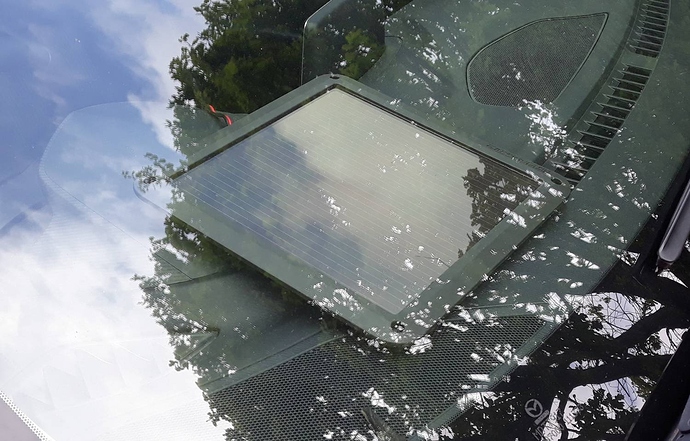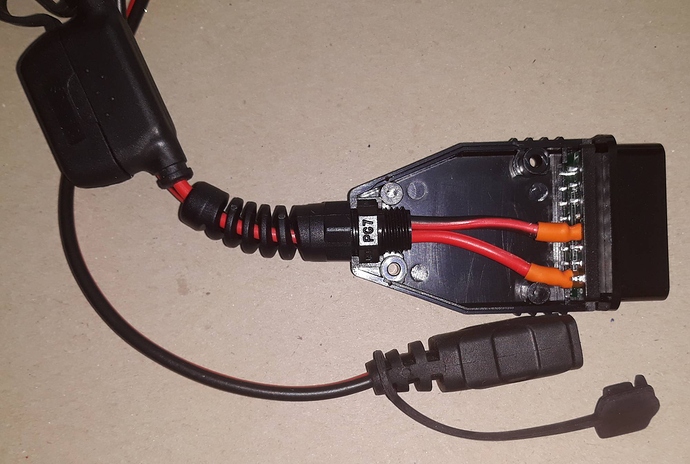Hi,
Does anyone use a solar trickle charger? I own a 25 Anniversary NC 3.75, it is stored in a garage that has no mains power to it, any advice would be helpful.
Many thanks,
Chris,
In general here in UK the amount of current from a solar cell is about a quarter of the claimed midday rating, mainly because we are so far North and the sun is low in the sky.
Then take into account short winter days with only a few hours of direct sunshine from the correct direction. I posted about this in 2019 although the pictures seem to have gone missing, but the useful link to solar panel theory in the Wiki still seems OK.
Then also consider how efficiencies vary wildly between different technologies in solar cells.
As a very rough rule of thumb here in winter on a dry sunny day with the panel facing due South and at the optimum angle from the vertical (not horizontal now) you can expect about a twentieth of the claimed daily Ampere-hours.
I did some experiments during the first lockdown and found an another loss, putting the panels inside the Mazda3 windscreen cuts the power in half again even when its sparkling clean. This was a NOCO BLSolar2, effectively useless.
In theory the stack of diodes in the panel should block any discharge current from the battery at night, but I found this was not the case on one of the two and I added a series blocking diode as well.
The OBDII socket provides a useful tap directly back to the battery, permanently live with only a 10A fuse in the way. That was the route I used.
My conclusion was either find a very big one (as big as the whole windscreen) with the blocking diode or don’t bother. It is cheaper to invest in a Smart charger for a monthly boost, and cheaper still to lift the negative terminal from the battery…
Even if one of t hese won’t actually charge the battery, might it at least slow down the rate of discharge??
Yes - I concur with most of Richards post (although I haven’t done any measuring), but mine definitely slows down the rate of discharge.
I have an AA-branded panel plugged into the OBD socket and it means that the car will not have a flat battery after standing for a month or more, even in winter. It is pointed due South and propped up on the dashboard.
Yes, possibly, and with a blocking diode. But will it be cost effective?
And not all panels have an effective blocking diode, and the only way to test for it is to connect the panel across the battery and measure the charging currents in the light and discharge (if any) in the dark.
Note that an ordinary test meter does not produce a high enough test voltage to overcome the photodiode-stack’s leakage threshold. See more about how the photodiodes work in that wiki article I mentioned above.
.
Some Theory digested from the Wiki.
The limitations of the photovoltaic array are;
-
The surface area (how much light it can catch, and therefore how much current.)
-
The number of cells in the array (setting the maximum open-circuit voltage.)
-
The `intrinsic’ (internal) series resistance (which limits the short-circuit current regardless of how much light is hitting it.)
-
How hot it gets (hotter means more internal leakage and lower open-circuit voltage.)
.
Some Practical Experiments I did a couple of years ago.
My NOCO amorphous silicon array has 31 photodiodes arranged as stripes across the 20cm x 20cm panel. The size is typical, but it’s inadequate for an NC at UK latitudes; five times the area would actually be OK long-term as a “Battery Maintainer” if correctly mounted.
Its open-circuit voltage (when it self-discharges through the 31 diodes) depends on how much light is coming in and varies from about
27V (very bright sunlight, about 350mA short-circuit current) down to about
18V (bright indoors light, about 5mA short-circuit current)
That measurement in UK 2020 mid-summer bright sunshine at noon had the help of some mirrors (about a metre square of kitchen foil) to concentrate more light on it to try and approximate equatorial sunshine and see just how much output was absolutely possible.
And in the dark of course, 0V and 0mA. Crucially there was no “discharge current” when I hooked it up to a bench supply set to 14.5V, so a battery would have been happy. I re-checked it a few minutes ago to make sure this was the right panel (I binned the other two brands for various reliability issues.)
Maximum output power available from any solar array is a trade-off between load voltage and current and intrinsic resistance. In the case of this “2.5Watt” Noco panel, it is best matched with a normal “12V” battery charging at about 13.5V with the nominal 180mA, because of the panel’s intrinsic series resistance of about 75 Ohms. However it will still charge lower voltage batteries (eg 6V) with similar amounts of current, just also with lower power into the battery because more power is being lost in the intrinsic resistance of the panel.
Under best circumstances here in the UK I expect it to charge at between 30mA to 100mA at midday. And then bear in mind our wet and rainy, overcast skies, aggravated by pollen pollution and sahara sand.
What a battery needs is Ampere-Hours (Ah), current during time, and in the UK winter active “sunshine-time” is short and current low.
Example 1. Three hours of midwinter effective charge averaging 25mA gives 75mAh which is roughly a tenth of what my NC might lose each day on dark current 32mA x 24h = 0.75Ah.
Example 2. Six hours of spring/autumn effective charge averaging 50mA gives 300mAh which is almost half of what my NC might lose each day.
Example 3. Nine hours of summer effective charge averaging 75mA gives 600mAh which is close to what my NC might lose each day.
Move to Spain and double those Ah figures, now it begins to make sense.
Your best bet (if possible) is to rig a solar panel on the garage wall/roof and feed a lead into the garage and attach to the battery in the car.
Obviously wire in a charge control box that prevents over charging etc etc.
I believe you can actually get the complete kits now off eBay/Amazon.
Didn’t cost a lot either to be honest.
I did that with my motor home that was stored under cover on a farm.
Rigged it to charge both batteries and NEVER went flat and worked a treat.
Just an idea. ![]()
For winter charging the South facing wall is perfect because the sun is so low in the sky.
In the summer it is less efficient but this is actually an advantage and will mitigate possible overcharging.


